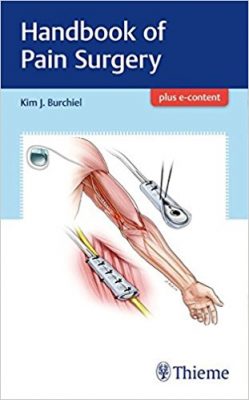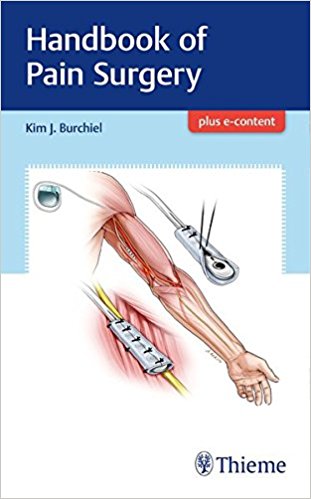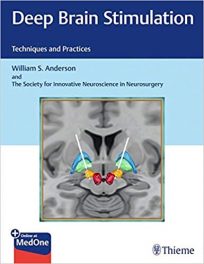 Editor: Kim J. Burchiel, MD
Editor: Kim J. Burchiel, MD
Publisher: Thieme – 383 pages, with 94 illustrations
Book Review by: Nano Khilnani
The editor Dr. Kim J. Burchiel, a recognized expert on trigeminal neuralgia, developed a book entitled Surgical Management of Pain that was published in 2002. His goal then was “to provide a compendium of knowledge in the area of pain surgery that would both organize our approach to difficult problems, and to open a discussion of strengths, weaknesses, and controversies that constitute this field.” He writes that he believes that goal was accomplished with that book.
The second edition of that book which came out in 2014 “purposely omitted what I believed were outmoded procedures and conceptual inconsistencies, but retained the original objective of focusing attention on the possibilities of surgical pain management,” Dr. Burchiel writes.
This present book is an updated one on the subject of alleviating pain through surgery. It is in paperback form unlike his other two books, and his intention is to “place it into more hands to inspire the next generation of practitioners, and to continue this important discussion.’ So, in accordance with fulfilling that mission, it has just been released in 2018.
Forty-one specialists in neurology, neurosurgery, anesthesiology, and other related fields authored the 24 chapters of this book we name below to provide you an overview of what you will find in it. The contributors are all from around the United States except three from Turkey and one from France.
- Pain Medicine
- Approach to the Patient with Chronic Pain
- Management of Pain by Anesthetic Techniques
- Pain Surgery Techniques and Procedures
- Spinal Cord Stimulation
- Spinal Cord Stimulation: Patient Selection
- Spinal Cord Stimulation: Equipment and Implantation Techniques
- Peripheral Nerve Stimulation
- Peripheral Nerve Stimulation
- Occipital Nerve Stimulation
- Trigeminal Neurostimulation for Neuropathic Facial Pain
- Intrathecal Therapy
- An overview of the Rational Use of Intrathecal Analgesic Therapies
- Intratehcal Drug Administration: Patient Selection and Implant Technique
- Procedures for Cranofacial Pain
- Surgical Operations for Facial Pain
- Microvascular Decompression for Trigeminal Neuralgia
- Trigeminal Rhizotomy
- Trigeminal Neurectomy
- Stereotactic Radiosurgery for Trigeminal Neuralgia
- Percutaneous Radiofrequency Trigeminal Gangliolysis for Trigeminal Neuralgia
- Percutaneous Retrogression Glycerol Rhizolysis
- Percutaneopus Balloon Compression for Trigeminal Neuralgia
- Intracranial Procedures for Nontrigeminal Neuralgias
- Percutaneous Computed Tomography-Guided Trigeminal Trigeminal Tracheotomy and Nucleotomy
- Destructive Procedures
- Overview of Destructive Neurosurgical Procedures for Pain
- Facet Blocks and Denervations
- Dorsal Rhizotomy and Dorsal Root Ganglionectomy
- Percutaneous Computed Tomography-Guided Cordotomy for Pain
- Midline Myelotomy and the Interruption of the Postsynaptic Dorsal Column Pain Pathway for the Treatment of Visceral Pain
- Dorsal Root Entry Zone Lesions
List of Videos:
- Video 1: Percutaneopus Balloon Compression for Trigeminal Neuralgia
- Video 2: Nevus Intermedus Transsection for Geniculate Neuralgia
- Video: 3: Percutaneous CT-Guided Trigeminal Tractotomy and Nucleotomy
- Video 4: Percutaneous CT-Guided C1-C2 Anteriolateral Cordotomy
- Video 5: Microsurgical DREZotomy for Neuropathic Pain
To watch the videos, go to the inside front cover of your book, retrieve the access code, then go to this site: www.MediaCenter.Thieme.com and when promoted during the registration process, enter that code.
Major features of this book:
- Use of spinal cord stimulation in the management of failed back surgery syndrome
- Pros and cons of nerve surgery for peripheral neuropathic pain
- Overview of intrathecal analgesic therapies including patient selection and implant techniques
- Innovative treatments for intractable pain such as dorsal toot entry zone (DREZ) lesioning
- More than 130 superb color illustrations by Andy Rekito elucidate pain syndromes and procedures
- Videos posted in the Thieme MediaCenter provide further guidance on select surgical techniques
Advancements in basic sciences, in the technology of neuro-imaging and in progressively more sophisticated therapeutic interfaces, have increased the capabilities of functional neurosurgery.
All these have been welcome changes to neurosurgeons (and their patients) because intractable pain syndromes are among the most challenging to this group of medical specialists. Fortunately, this handbook representing the work of 41 neurologists led by Dr. Burchiel, provides the important information and guidance needed to solve the problems faced by these specialists in their work.
Editor:
Kim J. Burchiel, MD, FACS is John Raaf Professor and Chairman Emeritus of the Department of Neurological Surgery, and Professor of Anesthesiology and Perioperative Medicine at Oregon Health and Science University in Portland, Oregon.







